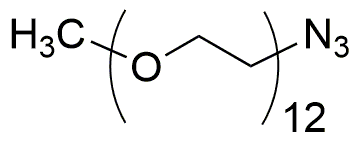Methyl-PEG12-azide is widely utilized in research focused on:
- Bioconjugation: This compound serves as a versatile linker in bioconjugation processes, allowing researchers to attach biomolecules such as proteins or antibodies to surfaces or other molecules, enhancing the development of targeted therapies.
- Drug Delivery Systems: Its unique properties enable the formulation of drug delivery systems that improve the solubility and stability of therapeutic agents, making it particularly valuable in the pharmaceutical industry for developing more effective treatments.
- Polymer Chemistry: Methyl-PEG12-azide is used in synthesizing functionalized polymers, which can be tailored for specific applications in materials science, such as creating hydrogels for biomedical applications.
- Click Chemistry: This compound is a key player in click chemistry reactions, facilitating the rapid and efficient formation of stable bonds between molecules, which is crucial in developing new materials and drug candidates.
- Surface Modification: It allows for the modification of surfaces in various applications, including biosensors and medical devices, enhancing their functionality and biocompatibility.
General Information
Properties
Safety and Regulations
Applications
Methyl-PEG12-azide is widely utilized in research focused on:
- Bioconjugation: This compound serves as a versatile linker in bioconjugation processes, allowing researchers to attach biomolecules such as proteins or antibodies to surfaces or other molecules, enhancing the development of targeted therapies.
- Drug Delivery Systems: Its unique properties enable the formulation of drug delivery systems that improve the solubility and stability of therapeutic agents, making it particularly valuable in the pharmaceutical industry for developing more effective treatments.
- Polymer Chemistry: Methyl-PEG12-azide is used in synthesizing functionalized polymers, which can be tailored for specific applications in materials science, such as creating hydrogels for biomedical applications.
- Click Chemistry: This compound is a key player in click chemistry reactions, facilitating the rapid and efficient formation of stable bonds between molecules, which is crucial in developing new materials and drug candidates.
- Surface Modification: It allows for the modification of surfaces in various applications, including biosensors and medical devices, enhancing their functionality and biocompatibility.
Documents
Safety Data Sheets (SDS)
The SDS provides comprehensive safety information on handling, storage, and disposal of the product.
Product Specification (PS)
The PS provides a comprehensive breakdown of the product’s properties, including chemical composition, physical state, purity, and storage requirements. It also details acceptable quality ranges and the product's intended applications.
Certificates of Analysis (COA)
Search for Certificates of Analysis (COA) by entering the products Lot Number. Lot and Batch Numbers can be found on a product’s label following the words ‘Lot’ or ‘Batch’.
*Catalog Number
*Lot Number
Certificates Of Origin (COO)
This COO confirms the country where the product was manufactured, and also details the materials and components used in it and whether it is derived from natural, synthetic, or other specific sources. This certificate may be required for customs, trade, and regulatory compliance.
*Catalog Number
*Lot Number
Safety Data Sheets (SDS)
The SDS provides comprehensive safety information on handling, storage, and disposal of the product.
DownloadProduct Specification (PS)
The PS provides a comprehensive breakdown of the product’s properties, including chemical composition, physical state, purity, and storage requirements. It also details acceptable quality ranges and the product's intended applications.
DownloadCertificates of Analysis (COA)
Search for Certificates of Analysis (COA) by entering the products Lot Number. Lot and Batch Numbers can be found on a product’s label following the words ‘Lot’ or ‘Batch’.
*Catalog Number
*Lot Number
Certificates Of Origin (COO)
This COO confirms the country where the product was manufactured, and also details the materials and components used in it and whether it is derived from natural, synthetic, or other specific sources. This certificate may be required for customs, trade, and regulatory compliance.

